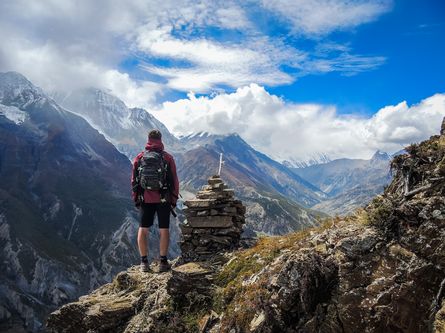The number one
Perhaps the Annapurna Conservation Area is the one that pioneered a successful conservation without armed personnel. With the help of the local people, this highland could be well protected. The Annapurna region covers an area of 7629 sq. km. Beginning from 790 m, the highest altitude reaches 8091 m at the Annapurna 1. This is - with more than 60,000 visitors a year - the most visited trekking area in the mountain region.

Annapurna Conservation Area
Annapurna Conservation Area Project (ACAP) has been running it's programs in the area with an aim to conserve nature and it's local community.
This region offers innumerable sights of water falls, mountains, natural flowers and rural settlements. If you trek from the west you will be travelling along the Kali Gandaki River. Apart from natural sights, the area is rich with flora and fauna. There are above 1200 plants with around 40 orchids and 9 species of rhododendron - the national flower. Around 100 mammals are here indigeous including the rare snow leopard and blue sheep in the upper sub-alpine area, 478 species of birds such as the protected multi-coloured Impheyan, koklas and blood pheasants. 39 reptiles and 22 amphibians and many types of butterflies live in the area.


Attractions
Reaching beyond the Himalayas, on foot or by flight, this is one of the most fascinating expereince while trekking in the Annapurna Circuit. Here you can see the above 8000 m mountains like Dhaulagiri standing right infront of you.
If you start from Pokhara, Ghandruk will be your first expereince where you will see the locals have conserved ecology and at the same time have earned their livelihood through tourism. From Poon Hill above Ghorepani you can have a panoramic view of the Annapurna ranges to the north. In Tatopani there are natural hot water springs, that offer an excellent place to relax and bathe.
Annapurna region has around 120000 human population from 10 different ethnic cast groups. For more nature and cultural sightseeing go towards the north at Kagbeni, where you can continue onto explore the Upper Mustang - the once forbidden Kingdom. Or trek towards the Muktinath Temple, the Hindu pilgrimage at the height of almost 4000 m. Further ahead is the Thorung La Pass at an altitude of 5410 m. If you want to climb over the pass it is better to do it from the east side, going around.
Climate
Best season for trekking is autumn from october to december and spring from fabruary to may. The region near Pokhara has almost double rainfall like Kathmandu. But in the mountains it has less rain, especially north of the range of Annapurna and Dhaulagiri. In this area its very dry during the whole year.
Getting there
The Area is easily accessed from Pokhara. A three hour bus drive to Beni in the west and start trekking into the area, or a one hour bus drive to Besi Sahar in the east to start the Annapurna Circuit trek. A one hour bus drive to Naya Pul (Birethanti) to start the trek to Annapurna Base Camp or Jomsom, or fly to Jomsom from Pokhara and trek back down.
Entry fees
Trekking permit per person per entry.
- Upper Mustang Restricted Area Permit for all foreigners: US $500 per person for the first 10 days and US $50 per person per day thereafter.
- You need also a permit for the Annapurna Conservation Area